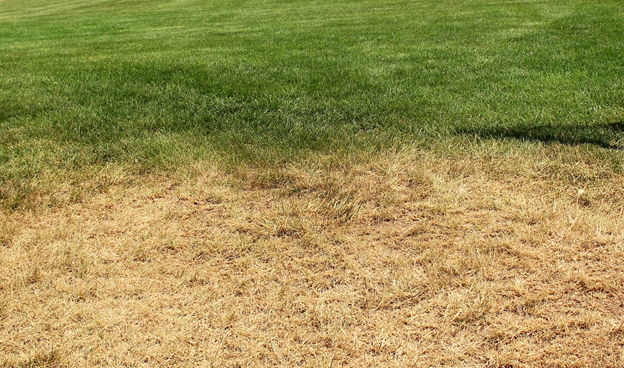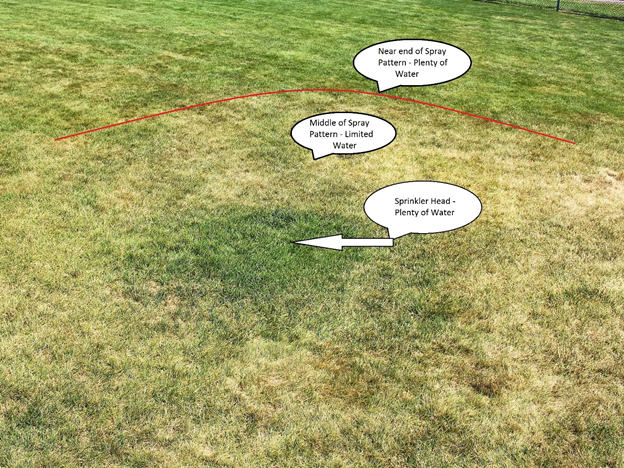Table of Contents
ToggleLast Updated on March 3, 2025
What happens if I don’t water?
All living things need water to survive, and your lawn is no exception. Each summer, many lawns in our area experience heat and moisture stress, causing them to turn brown. Without proper irrigation, these lawns may remain brown until regular and consistent rainfall returns. Correctly watering your lawn will make a drastic difference in health and color as depicted in the photo below.
Before going over how to water a lawn correctly, we will first review a few bad practices we often see. Typically, sprinkler systems have an initial setting to water daily for 20 minutes per zone and are set to run in the middle of the day. Watering for a short duration puts down very little water that actually gets to the roots, and watering in the middle of the day is not very effective as a significant amount of moisture will be lost to evaporation. This does not benefit your lawn or your wallet. Another common mistake is starting irrigation at sundown which leaves the lawn wet for far too long, increasing the likelihood of disease.
How to water a lawn
Fairway Green Inc. would like to set the record straight on how to water a lawn. It all starts by maintaining good soil moisture before your lawn starts showing signs of drought stress. When it comes to watering, you want to mimic a heavy rainstorm, a lot of water at one time. Your lawn should receive roughly 1 inch of water per week. We recommend running underground sprinklers for 1 to 1 ½ hours per zone, twice a week. Rutgers University recommends that the best time to water your lawn is between Midnight and 6:00 A.M.
Things are a little bit different when it comes to how to water a lawn with a hose-end sprinkler. You still want to put down 1 inch of water per week and the watering to be done between Midnight and 6:00 A.M., but we recommend 4 hours per zone, once a week. Automatic timers and hose splitters (to water multiple sections at once) can be purchased at home improvement stores and will help you water the lawn without having to wake up in the middle of the night to turn on the water and move the sprinklers around.
If the lawn is not showing any improvement with the timing recommendations above, we suggest increasing the duration of the watering time per zone. For example, if you are watering 1 hour per zone (with an underground irrigation system) and it is not improving the color or growth of your turf, rather than adding on another day to your watering schedule, just add 30 minutes to your current watering time per zone. It is better to increase the time duration than to increase the frequency.
Sprinkler adjustments
Regardless of whether you are using underground sprinklers or ones connected to your hose, it is important to ensure the sprinkler heads are adjusted correctly. You want the water to be evenly distributed across the spray pattern of the nozzle, this will ensure a consistent color across your entire lawn. The photo below shows an underground sprinkler head (dark green circle near the bottom center of the photo) that is not adjusted correctly. The majority of the water is being distributed near the sprinkler head and at the end of the spray pattern. The area between the sprinkler head and the end of the spray pattern is receiving less water and showing signs of stress.
One of many benefits to watering your lawn correctly is the deeper you water, the deeper the roots will grow. Once the root zone dries out, the roots will be forced to grow down deeper into the soil looking for more water. This will create a larger and stronger root system and an overall healthier grass plant.
When you decide to water your lawn, keep up with the watering for the rest of the summer. Just because your lawn turns green does not mean you can stop watering as the plants are still susceptible to drought stress. If you stop watering mid-summer, the lawn will use a lot of the food reserves (fertilizer) it has stored up and will weaken. If the turf is already showing signs of moisture stress and you are just beginning your watering schedule, it may take a few weeks for the lawn to show any improvement. Following the watering guidelines above will keep your lawn healthy during the stressful summer season.
If you are in our service area and have any questions related to watering, feel free to contact our office!



